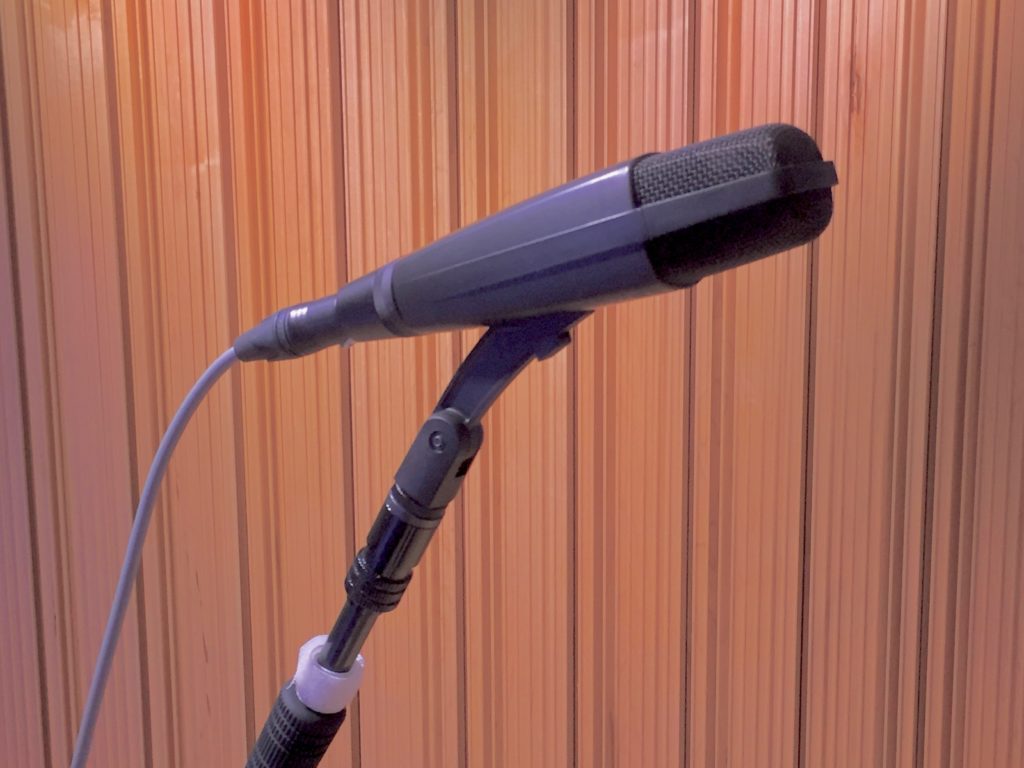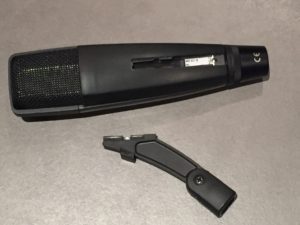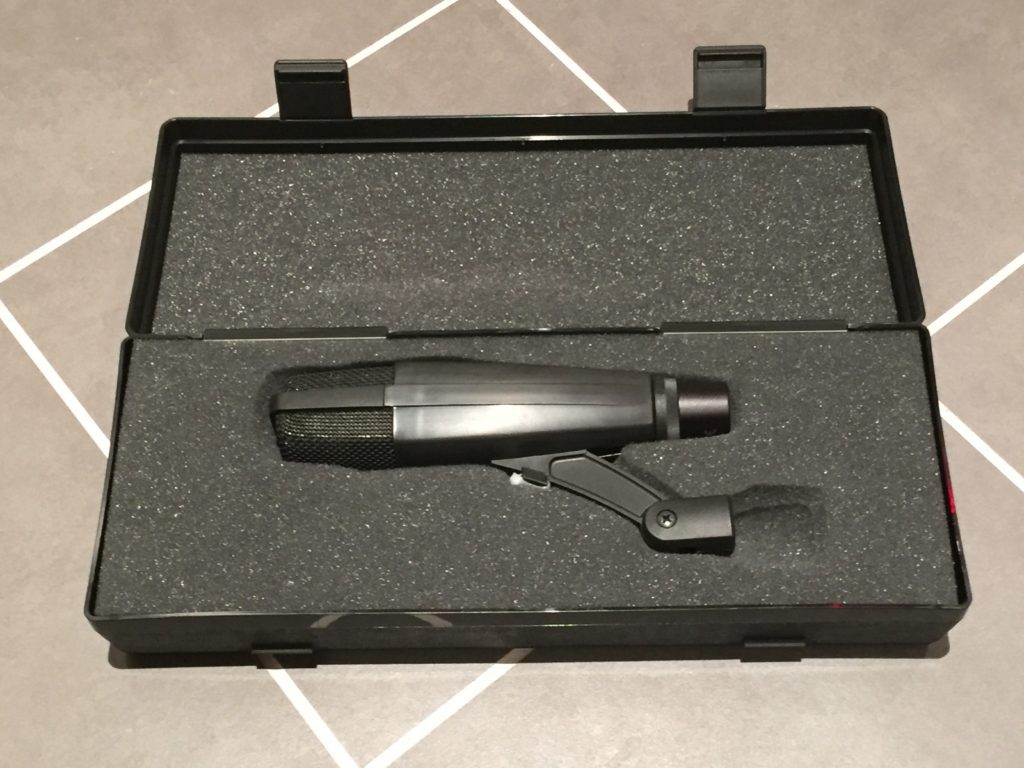Sennheiser’s MD421 dynamic microphone is a workhorse microphone. Originally intended as a general-use microphone for vocals and instruments, along the way it gained “killer app” status on tom drums. An unintended defect in the mic’s design, though, has been killing tom drums ever since. Here’s a little history on this famous microphone, and a neat little hack that semi-permanently solves a problem that drives audio engineers nuts.
Dynamically Yours
The MD421 is a dynamic coil microphone, meaning that it picks up sound using a drum-like diaphragm attached to a magnet. As the magnet moves perpendicularly through a coil of wire, it generates an audio signal that can be recorded or amplified. But the sensitivity of a dynamic microphone is hindered by a simple law of physics. Since the microphone picks up sound by the physical movement of a relatively heavy magnet moving through a coil of wire, it can take more air molecules to get the diaphragm vibrating than it does in other capsule designs. Still, since dynamic microphones do not require an outside power source, and are much more durable than other designs, they are always the first choice on stage, outdoors, etc., where durability is more important than sound quality.
When the Sennheiser MD421 was introduced in 1960, though, it drew a lot of attention for what was, at the time, a fairly unusual combination of features. First of all, with a diaphragm of 27mm, it’s considered a “large diaphragm” microphone. That’s rare in a dynamic microphone because of the mass-vs-sensitivity issue, but a larger diaphragm contributes to better low-end frequency response. The MD421 sports a frequency response of 30-17,000 Hz, which is excellent for a dynamic microphone, especially in the low end, and especially for a design introduced more than 50 years ago.
Also, large diaphragm mics are usually built in what’s known as a “side address” configuration, meaning the microphone picks up sound through a grill perpendicular to the axis of the mic body. These work fine in the studio, but on stage or on camera, singing into the side of a microphone means the microphone body is blocking the performer’s face from the viewer.
Address Inquiries to the Front
The MD421, on the other hand, is a “front address” microphone. Sennheiser managed to cram a large-diagphragm design into a microphone body that could be easily held in the performer’s hand, and since the performer sings or speaks into the top of the microphone, using one on stage or screen didn’t block the view of the audience.
[blockquote]”Side address” microphones work fine in the studio, but on stage or screen, singing into the side of a mic means the microphone body is blocking the performer’s face.[/blockquote]
With those features–the durability of a dynamic microphone, and a frequency response more like a condenser microphone– Sennheiser markets the MD421 as “suitable for vocal transmission and miking up instruments in all fields of live sound transition.”

And indeed, for many years the MD421 could readily be seen in the hands of television reporters around the world. Since the mic’s square-ish profile prevents it from being used with a standard microphone clip, though, Sennheiser also designed a futuristic-looking clip that would allow the mic to be used as a desktop mic or on a regular microphone stand. The famed “voice of God” announcer Shadoe Stevens can be seen using a stand-mounted MD421 during his days in the bottom center square of TV’s Hollywood Squares.
Some say the MD421 looks a lot like a hand phaser from “Star Trek.” As a kid, I always thought the MD421 looked a little like a Remington “front-address” electric foil shaver — the kind made famous by Victor “I Liked Them So Much, I Bought the Company” Kiam on TV. I used to chuckle at the thought that a singer was getting a little touch-up on his stubble while crooning into an MD421, even if I didn’t know what the microphone was called.

A Killer Emerges from the…er…Shadoe
So while the MD421 was primarily known for its versatility as a vocal mic, along the way studio engineers discovered a killer application for the MD421: miking up the tom drums on a drum kit. As a dynamic mic, the MD421 is durable and relatively low-profile, and the 30-17,000 Hz frequency range and cardioid pickup pattern is great for getting the full body of a tom drum’s sound while making it relatively less sensitive to the splashy, higher frequency wash the cymbals are putting out just 18-24 inches away.
[blockquote]Along the way studio engineers discovered a killer application for the MD421: miking up the toms on a drum kit.[/blockquote]
Of course, to get the MD421 to face the toms while still letting the drummer hit the drumhead, the mic needs to be mounted so that it’s suspended over the drum, pointing down at the drumhead.
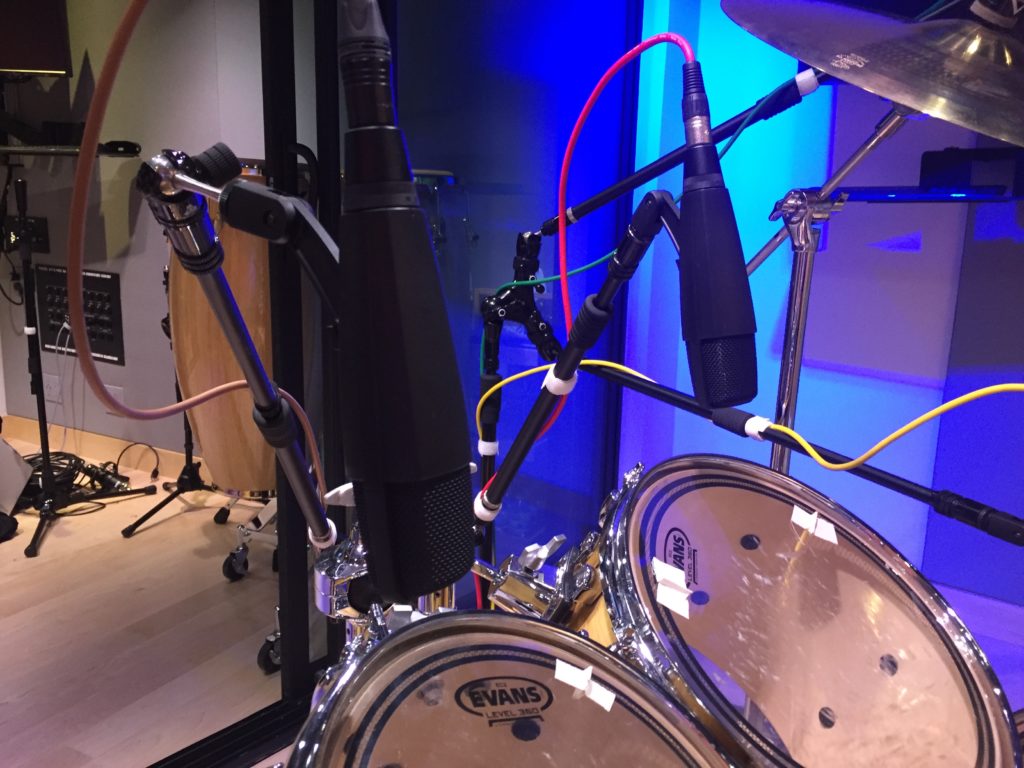
And therein lies a problem that has plagued studio engineers for years.
The MD421 has a thin rail along the bottom surface of the mic. The sexy, futuristic clip that Sennheiser designed for the MD421 is installed on the mic by sliding the microphone body backwards onto the rail until it locks in place. That lock is released using a small spring-loaded button. If the mic is set up on a stand, just push the button to release the lock, and then you can slide the mic forward and off the rail.
If the mic is positioned for typical vocal use, this is not a problem at all. You’re unlikely to touch or bump the release button while you’re holding the mic, and unless you pull on the mic at the same time, it’s not going anywhere. The clip just resets after you release the button.
But in the MD421’s other, killer-app usage–on tom drums–it’s a different story.
Since the mic is suspended pointing down, the added torque of the full weight of the microphone’s body leaning on the clip mechanism means that even the slightest glancing touch of the release button is enough to unlock the clip, sending the microphone careening downward like a microphone-shaped missile. A missile aimed squarely at the tom drum.
[blockquote]Even a glancing tap on the release button from a fat finger is enough to launch the microphone like a missile to the floor. And yet, in over 50 years on the market, Sennheiser has never redesigned the clip to correct this problem.[/blockquote]
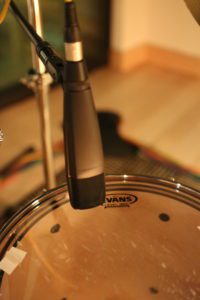
I can’t speak personally to how often this little defect actually causes any real damage. Dynamic microphones are pretty robust and can take a lot of punishment. And the MD421’s front edge is blunt enough that I would imagine it’s hard to actually punch a hole through the drumhead or damage the drum itself. Still, any time a microphone falls off and hits something, it has the potential to make a very loud noise–especially if the mic is fully cabled up, amped up and playing through the studio speakers.
I don’t know when the MD421 came into common use as a tom drum mic. If I had to guess, it was probably in the 70s, during the time when the use of 24-track recording tape made close-mic’ing every drum in the kit a practical possibility. If that’s the case, then this is a clip design that has been bedeviling studio engineers for over 40 years. And yet, Sennheiser has never redesigned it.
Why? Who knows. My suspicion is that the designers never imagined you’d have a need to use these microphones pointed straight down like you do when recording toms. In a more traditional position, it works just fine.
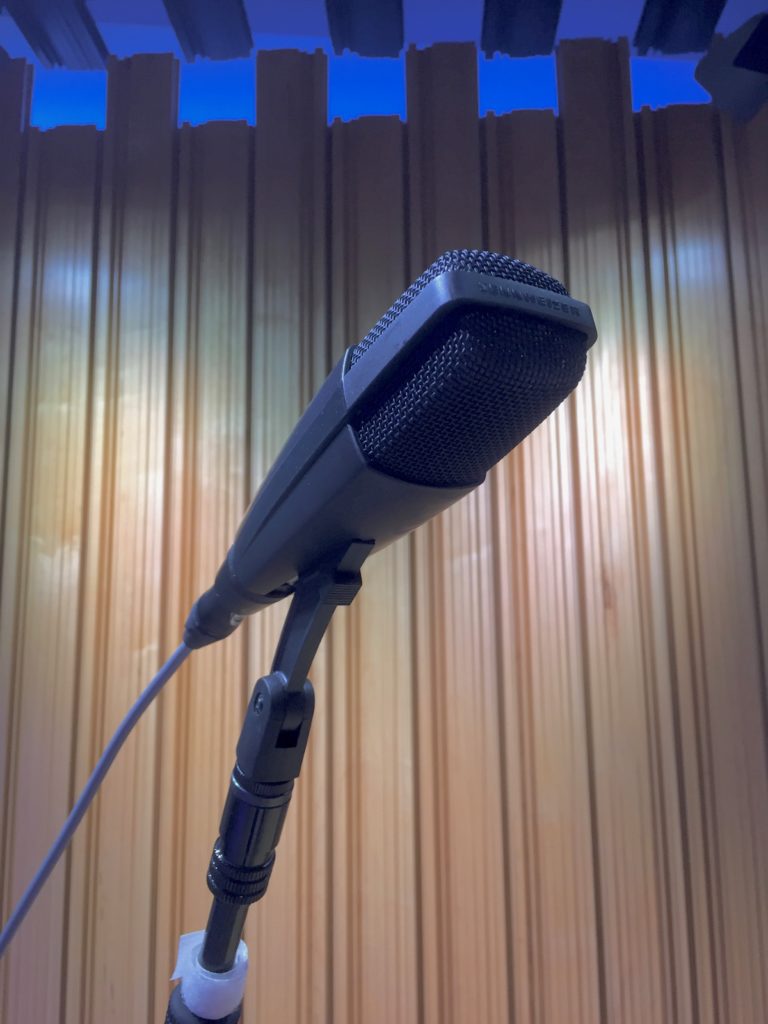
Caution: Studio Nerd Ahead
So with all that in mind, I got to thinking today about how someone might go about designing a modified clip to prevent the MD421 from falling off. I poked around the Internet, and, as you’d expect, there’s all sorts of ideas people have come up with to solve the problem, including gluing the mic to its clip (thereby preventing you from ever using it as a handheld mic again, a limitation which most studio owners really don’t care about) and 3D-printing all sorts of different-looking adapters that either replace the existing clip with one that doesn’t have a release button, or which shield the release button to prevent you from accidentally bumping it.
[blockquote]The Internet is littered with all sorts of ideas about how to correct the MD421’s clip problem. Here’s one more.[/blockquote]
But I came across another thread where someone mentioned using a twist tie from a bread bag, a paper clip, or even a length of bare copper wire to defeat the release button. That seemed like a good idea, and I thought maybe I should try that. I don’t keep bags of bread lying around the studio, though, and I didn’t have any paper clips or bare wire lying around, either. What I did have, and which I do seem to keep lying all over the studio, was a thin plastic zip tie. Would that work? Worth a shot. I delicately threaded the tie in the small gap between the body of the mic and the underside of the button, and slowly ratcheted up the tension until the zip was firmly wrapped around the button.
Taking a firm grasp of the mic clip, and suspending the mic body over a couch cushion just in case of accidental launch, I tried pushing the release button. Nothing! No wobbling, no slipping, no microphone missile. The zip tie blocks the button’s travel, preventing the button from releasing the spring that holds the clip in place.
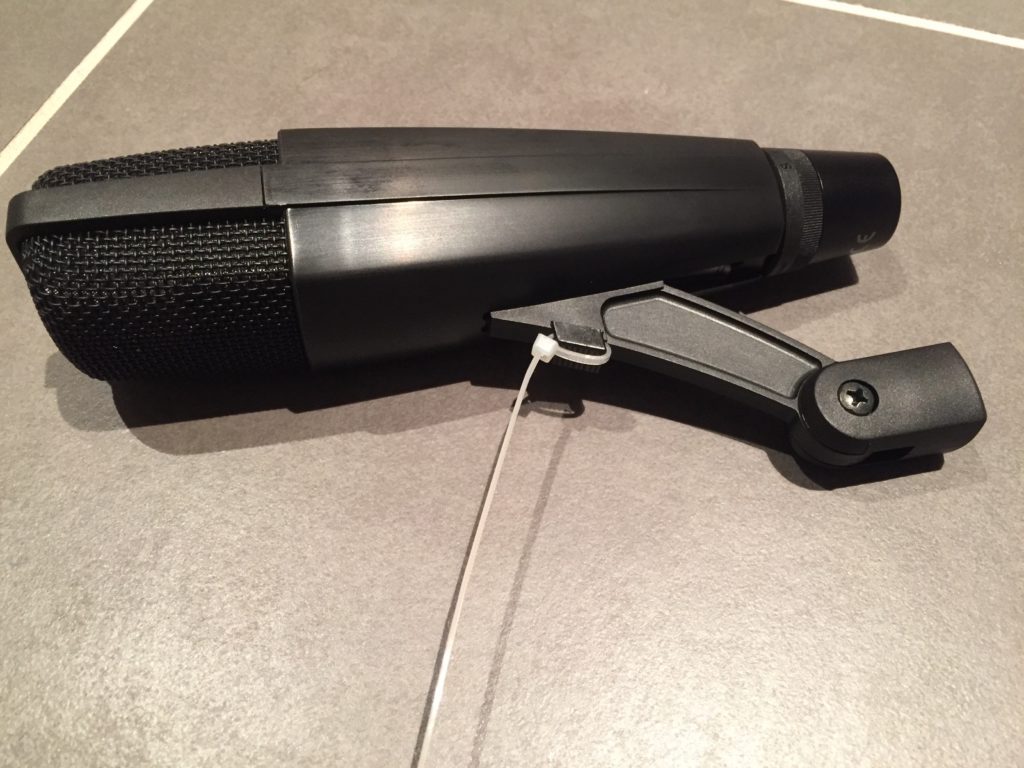
I am AMAZED how much better the clip is now. The release button is completely disabled, and that sucker isn’t going anywhere unless I grab a pair of snips and cut the zip tie out.
[blockquote]About a penny’s worth of plastic provides very firm, solid protection against accidentally launching the microphone.[/blockquote]
In my studio, I really never need to use a 421 in its “handheld” arrangement, so it did occur to me that maybe I should just permanently glue the clip to the mic. But then I wondered if permanently attaching the clip would prevent me from storing the microphone in its box. As it turns out, the box allows you to leave the clip attached to the mic while the whole thing is stashed in the box, so that is an option, too.
Still, not having to worry about the mic falling out of its clip without permanently modifying the microphone is a great solution in my mind! Less than a penny’s worth of plastic for very firm, solid protection against accidentally launching the microphone? Totally worth it.
Update – Jan 3, 2018: Commenter Mark Harris notes that Sennheiser DOES make a shockmount for the MD421, which apparently does a solid job of supporting the mic and doesn’t have the same itchy-trigger issues that the MD421’s stock mount has. But it’s $65. Ouch! Sennheiser is notorious for their spectacularly expensive accessories ($50 for a couple of pieces of metal, anyone?). Here’s hoping they’ll someday apply that precision metalworking to the stock clip…one can hope…

